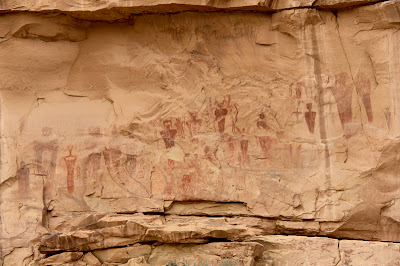Distance: 3.5 miles round trip
Elevation: 6,040 ft
Elevation Gain: 350 ft (cumulative)
Bathroom at Trailhead: No, nearest one is the Visitor's Center
Dogs: No, National Park
Date Hiked: 24 April 2013
 |
| Looking west and down, down, down, from Murphy Point in Canyonlands National Park |
The trail to Murphy Point in the Islands in the Sky section of Canyonlands National Park is one of the few longer hikes one can take and still stay on the mesa. It traverses sand and slickrock with ever-changing, end-of-the-world views. Be forewarned! Looking off into that abyss is a transcendent
Ozymandias kick in the solar plexus. One's whole life is reduced, in the casual stirrings of the desert wind, to meaningless drivel. Our weak brains can't even register the scale of the scenery without reducing it to a theatrical canvas backdrop. Your only hope is bring along sufficient chocolate chip cookies to stay grounded. A prolonged astral projection on Murphy's Point might just prove to be fatal.
 |
| Starting off in the deeply rutted road |
 |
| Stay to the right here |
 |
| Sagebrush |
The trail to Murphy Point begins 8.6 miles south of the Visitor's Center along a deeply eroded dirt track that looks like it was made by a column of 10,000 cattle all racing to the edge of the world. A half a mile in the route splits. Stay to the right or end up on the much longer Murphy Loop/Hogback Trail, which descends off the mesa into eternity returning a few geological ages later.
 |
| Looking northwest at the rock formations obscured by haze |
 |
| That is a cairn in the distance |
After the dirt road, the route eventually switches to an easy "find the next cairn", slickrock trail along a narrowing neck of earth.
Utah Juniper and
Sagebrush dot the landscape and occasionnaly obscure the views. You can wander all over the area but realize there is nothing but 1,500 ft of open air between you and an "oh heck" moment.
 |
| Floating over the desert landscape |
 |
| Sitting at the point looking down on the Murphy Hogback (that narrow elevation portion). You can see the Murphy Trail as it travels out and around the area. Bring lots of water if you venture that far. |
I did not go anywhere near the edge and so arrived, sanity intact. We had the entire place to ourselves, which is always a treat. Canyonlands is big and it is easy for folks to spread out...and never to be heard from again...at least until the chocolate chip cookies run out. Then they congregate back at the Visitor's Center where they gobble up T-shirts and refrigerator magnets. So plan ahead and stay awhile at the end of the trail. It is not often we get to transcend our banal existence for something the truly sublime.





















